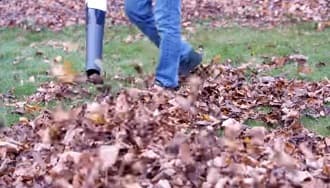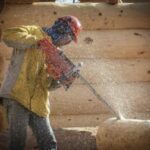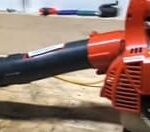As an Amazon Associate, this site earns commissions from qualifying purchases. For more information click here.
You have probably seen some people use leaf blowers in the rain. Some may have told you it is safe while others claim it is dangerous. So which one is it? This guide explains what you have to do when it comes to rain and wet conditions in general. As you will see, a lot of factors come into play that you have to consider.
Electric leaf blowers should not be used in the rain due to the risk of electrocution. You can use gas leaf blowers in light rain but stop if turns into a heavy downpour. To clean after a downpour, tilt the blower so any trapped water runs out and wipe the outer casing with a dry cloth.
Can You Use a Leaf Blower in the Rain?
Most leaf blowers are not waterproof, but they can handle a bit of rain. The casings for leaf blowers are tight and designed to keep water out. How much water and humidity a leaf blower can handle depends on whether it is gas, electric or battery.
Battery and Electric Leaf Blowers
An electric leaf blower will not get damaged by a drizzle. If the unit is not plugged in, it works like a battery leaf blower and can withstand some humidity and light rain. It is a different matter if the blower is plugged in however.
Do not use a plugged electric leaf blower in wet conditions. There is a risk of electrocution as water can seep into the motor. If the cable is fayed this can cause serious injury as well.
Even if the blower is not plugged in, heavy rain can damage the motor. Electronic components are sensitive to water, which is why they are only used in dry conditions. If water gets into the motor it will cause irreparable damage and must be replaced.
Gas Leaf Blowers
Gas blowers can handle rain unless it is really heavy. A high quality gas blower can still function in a downpour and you probably have to submerge the leaf blower to cause damage.
Even then it could still be salvageable. Remove all the water, drain the fuel and dry it. Fill it with fuel and the machine should work. If there is a problem, you can perform a coil ignition test.
This assumes that the spark plug and other parts were not damaged by the water. You will need to replace those to get the blower to work. If water gets into the fuel or other engine parts, the blower might stop working.
So to sum it up: leaf blowers should be fine with a light drizzle. If it runs into a downpour, stop using it and dry the blower. A good example of a heavy duty leaf blower is the Poulan Pro PR48BT which can handle rain just fine.

Will Wet Conditions Damage a Leaf Blower?
Even if you do not use a leaf blower in the rain, it can still get wet. You might forget to bring the tool inside and it gets rained on for instance. Or you are cleaning the tool and accidentally drop it into a puddle of water.
A bit of water is not going to damage a leaf blower. If only the outer casing gets wet, there is nothing to worry about. Problems can occur if the electronics and other machine parts get wet. This could lead to a slowdown in performance or the blower could stop working altogether.
Dry your leaf blower as soon as possible. Rust could build up and that could make the tool unusable. Water inside an electric or battery blower will also cause major issues and if not removed, lead to permanent damage.
How to Clean a Wet Leaf Blower
Whether your leaf blower is 2-stroke or 4-stroke you should dry it right away to avoid damage. After cleaning and drying, try the blower to see if it still working.
Step 1
Turn the leaf blower off. If you are using an electric blower, unplug the cable from the power source. Remove the battery if you are using a battery powered blower.
Step 2
Wipe the leaf blower with a dry cloth. Now tilt it one way so water comes out. Turn it upside down and give it a light shake if you suspect a lot of liquid is trapped. If your blower runs on gas, check the fuel compartment if water has gotten in. If you believe it has, empty the fuel tank.
If you have a battery blower like the CRAFTSMAN 20V MAX, open the battery compartment. Remove the battery and wipe it dry. Dry the compartment too. Put the battery back on after the blower has completely dried and try it again.
Step 3
This step is only for those who have experience tinkering with engines and motors. Remove the engine cover and inspect the interior. Check if the sparkplugs or other parts are damaged and replace them.
If you are not sure what to do, dry the engine with a towel. Do not change anything. Wait for a few days until the leaf blower is totally dry.
If you do not want to wait a few days you can use a blow dryer. This can dry your leaf blower quickly, but it might generate too much force and cause damage. Set the blower to the lowest setting or just let the tool dry over a few days.
Once the blower dies, turn the power on. If it does not work, some engine parts are damaged and requires servicing.
If you are into DIY, replace the damaged engine parts and reassemble it. You should be able to get the blower up and running.
Do Leaf Blowers Work on Wet Leaves?
Leaf blowers can be used on wet leaves. It will not cause any damage but it will force the tool to work harder. Wet leaves are heavier than dry leaves so your blower will need a greater MPH and CFM.
If you only need to pick up a few wet leaves it will not be a problem. A large amount however, can strain an electric or battery blower. Because the leaves are soaking wet it could slow the blower down and reduce its efficiency.
The best thing you can do is to let the leaves dry up. This will reduce its weight and make it easier for the blower to do its job. Consider getting a gas leaf blower if you have to clear wet leaves regularly.
What Leaf Blower Can Clear Wet Leaves?
There are many types of leaf blowers, from heavy duty gas units to handheld models that run on batteries. A leaf blower with a minimum 500 CFM and 150-190 MPH is ideal. Here are other things to consider..
- The 500 CFM is the minimum required, and if you can get an 800 CFM model that is even better.
- A gas blower is more suited for clearing wet leaves. As explained earlier, most electric and battery blowers are not well suited for rainy and wet conditions. Gas blowers are also more powerful and can handle the leaves’ extra weight. There are however, powerful battery blowers that can work.
- Powerful nozzles. The narrow the nozzle, the more forceful the air pressure. This is necessary because heavy leaves need additional pressure.
- Water resistance. Some leaf blowers are waterproof and others water resistant.. What is important is that the blower can handle wet conditions.
- Design. The leaf blower must be built to last. Wet leaves require more air pressure, which means the blower has to exert more force to work. If you clear these kinds of leaves often, it could take its toll on the engine. A powerful leaf blower is needed for this type of work.
When you do get your hands on a leaf blower capable of picking up a lot of wet leaves, maintain it regularly. Clean after each use and follow the directions given in your owner’s manual. This will increase the lifespan of your leaf blower and provide better service.

I love the outdoors and all the tools for maintaining gardens, yards and lawns. The only thing I am more passionate about is sharing what I know about garden and outdoor equipment.


